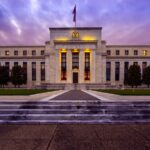Earlier this week, President Trump announced that he would impose a 10% baseline tariff on all imports to the U.S., along with additional duties imposed upon some of the nation’s biggest trading partners.
The announcement has sent a ripple effect throughout the financial markets, as goods ranging from Italian coffee and Japanese whisky, to Taiwanese semiconductors and sportswear made in Asia, will be impacted and hit consumers where it hurts the most … their wallets.
“Large and persistent annual U.S. goods trade deficits have led to the hollowing out of our manufacturing base; inhibited our ability to scale advanced domestic manufacturing capacity; undermined critical supply chains; and rendered our defense-industrial base dependent on foreign adversaries,” said President Trump in his Executive Order. “Large and persistent annual U.S. goods trade deficits are caused in substantial part by a lack of reciprocity in our bilateral trade relationships. This situation is evidenced by disparate tariff rates and non-tariff barriers that make it harder for U.S. manufacturers to sell their products in foreign markets. It is also evidenced by the economic policies of key U.S. trading partners insofar as they suppress domestic wages and consumption, and thereby demand for U.S. exports, while artificially increasing the competitiveness of their goods in global markets. These conditions have given rise to the national emergency that this order is intended to abate and resolve.”
The tariffs announced will hike up the price of imported products, and that price increase is generally absorbed by the importer or passed on to the end consumer of the good, usually in some combination. For most goods, the cost is passed on to consumers. Any tariff on international building materials will inevitably raise the cost of housing, with consumers absorbing those costs in the form of higher home prices.
“President Trump announced a sweeping range of tariffs on Wednesday afternoon that have sent the markets recoiling, and the impact of which will be seen in mortgage rates reported in the coming weeks,” observed Realtor.com Senior Economist Joel Berner. “The 10-year Treasury has dipped even further this morning, as investors are exiting the stock market, so it’s likely that mortgage rates will continue to come down in the coming months as a result. This shock to the system will be felt in the housing market for the rest of the year.”
Pricing Out Prospective Buyers
According to the National Association of Home Builders (NAHB), $204 billion worth of goods were used in the construction of both new multifamily and single-family housing in 2024. Of this share, $14 billion of those goods were imported from outside the U.S., with approximately 7% of all goods used in new residential construction having originated from a foreign nation.
Berner noted that “noticeably absent from the specific targets in Trump’s speech were Canada and Mexico. In the housing space, Canada is a key supplier of lumber and Mexico is a key supplier of lime and gypsum for drywall. The ability of American homebuilders to produce affordable new inventory is directly linked to their ability to import key materials from our neighboring countries. We are encouraged to see that specific tariff hikes for home construction inputs from Canada and Mexico were not on the President’s agenda. It is estimated that almost $10,000 of the cost of a new home is due to tariffs, which in the current environment of high listing prices and high mortgage rates leads to further affordability challenges for prospective buyers.”
In terms of Canadian and Mexican imports, two essential materials used in new home construction, softwood lumber and gypsum (used for drywall), are largely sourced from these two countries. NAHB reports that of the $8.2 billion worth of sawmill and wood products imported in 2024, nearly 72% of these imports came from Canada. Total imports of sawmill and wood products from Canada totaled $5.9 billion. The U.S. imported $481 million worth of lime and gypsum products in 2024, with 74% of these products originating from Mexico. Imports of lime and gypsum products from Mexico totaled $354 million in 2023. Additional raw materials, from steel and aluminum to home appliances, are sourced from China
“Tariffs may sound like a strategy to boost U.S. manufacturing, but for working families, they hit like another bill they can’t afford,” said Marisa Calderon, Prosperity Now President & CEO. “A 25% tariff on building materials could raise the cost of a modest home by up to $10,000, which is the difference between qualifying for a mortgage and getting priced out.”
Dr. Selma Hepp, Cotality Chief Economist, added, “The announced ‘Liberation Day’ tariffs could push home construction costs up by 4% to 6% over the next 12 months. When factored in with the current inflation levels, there will be an estimated 10% increase in material prices, broadly averaging around a $17,000 to $22,000 increase in construction cost per home.”
Industry Responds to Tariff Imposition
As affordability concerns already grip a tightening housing market, many fear the hike in prices due to tariffs will push more prospective buyers to the sidelines. With the cost of building materials having already risen by 34% since December 2020, recent data from the NAHB/Wells Fargo Housing Market Index (HMI) March 2025 survey reveals that builders estimate a typical cost effect from recent tariff actions at $9,200 per home.
“Trump’s tariffs are reshaping affordable housing in ways few anticipated, raising costs for developers, while deepening affordability challenges for renters,” said Derrick Barker, CEO/Co-Founder of Nectar. “As supply constraints worsen, we’ll see fewer new projects and rising rents in the short term. But longer-term opportunities exist for those willing to innovate and invest in the future, whether through domestic production or innovations in construction practices.”
NAHB sent a letter to the White House on January 31 urging the President to exempt critical building materials from his tariffs on Canadian and Mexican goods so vital to the nation’s housing construction market.
“Our sector relies heavily on a diverse and cost-efficient supply chain for building materials such as lumber, steel, gypsum, and aluminum,” said Carl L. Harris, 2024 Chairman of the Board for the NAHB in the letter. “While home building is inherently domestic, builders rely on components produced abroad, with Canada and Mexico representing nearly 25% of building materials imports. Imposing additional tariffs on these imports will lead to higher material costs, which will ultimately be passed on to home buyers in the form of increased housing prices. Further supply chain disruptions from increased tariffs coupled with increased demand for materials could also hinder rebuilding efforts in areas affected by natural disasters, which you have pledged to help rebuild as quickly as possible.”
The Structural Building Components Association (SBCA), an international trade association representing manufacturers of structural building components, claimed that sawmill and wood preservation firms reported lower capacity utilization rates coupled with level production and capacity throughout 2024. Despite no growth in production in 2024, utilization rates have trended downwards since 2017, as sawmills have expanded production capability. Even with more production capability, real output has not followed as output remains lower than 2018.
“Tariffs are expected to raise costs. Whether they cause a one-time price level or ongoing inflation will depend on a variety of factors, but my expectation today is that they are more likely to cause a one-time reset that adds to measured inflation in the near term, but not necessarily sustained inflation,” said Danielle Hale, Chief Economist with Realtor.com. “I do think they raise inflation risk however, so we’ll have to watch this closely. But I don’t think that the inflationary impact from tariffs will be the bigger factor for interest rates. In fact, early reaction from the markets suggests that investors are far more concerned with the economic growth implications of this trade policy, and we’re seeing financial markets move lower and bond prices move higher, which means lower interest rates.”
Passing the Buck
And as costs mount, it is today’s homebuyer who is most deeply impacted in the end, as they are the inevitable party these news costs are dished off to.
“In times of economic uncertainty or stress, there is often a capital flight to the safety of U.S. Treasury bonds, which can lower long-term bond rates and, in turn, lower mortgage rates, offering an affordability boost to the housing market,” noted Mark Fleming, Chief Economist at First American. “This spring, as new listings are increasing and supply is growing, if affordability improves, it may stimulate more demand.”
Mortgage lenders may also face some cuts due to the tariff imposition, as Rajeev Kumar, EVP of Flatworld Solutions, points out.
“The combination of increased operational risks, higher default potentials, and lower sales volumes can significantly compress profit margins for lenders,” said Kumar. “In such a scenario, lenders must either accept lower profitability or attempt to pass increased costs onto borrowers through higher rates and fees, further exacerbating affordability issues. Moreover, as lending institutions navigate tighter profit margins, there could be broader implications for innovation and investment in the mortgage industry.”
As costs are passed on, the long-term impact on the lending space may resonate beyond.
“Reduced profitability limits the resources available for lenders to invest in technology, customer service enhancements, and competitive lending products, ultimately diminishing the industry’s long-term growth potential,” added Kumar.
Calderon points out that “families are already struggling to keep up with rent, groceries, and childcare. The median household is spending over 30% of their income just on housing, and that’s before tariffs kick in. Add higher costs for cars, electronics, and everyday essentials, and there’s little left to save for the future, let alone a down payment.”







